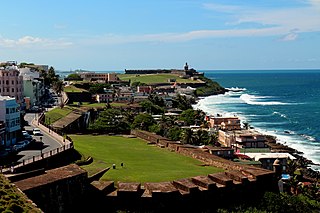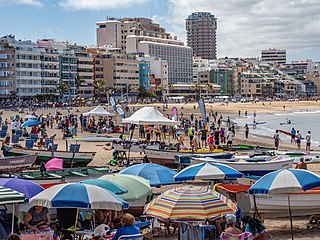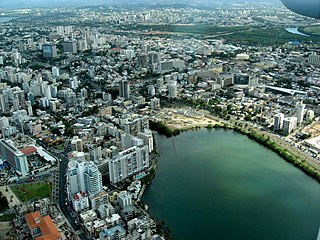
Puerto Rico, officially the Commonwealth of Puerto Rico, is a Caribbean island and unincorporated territory of the United States with official Commonwealth status. It is located in the northeast Caribbean Sea, approximately 1,000 miles (1,600 km) southeast of Miami, Florida, between the Dominican Republic and the U.S. Virgin Islands, and includes the eponymous main island and several smaller islands, such as Mona, Culebra, and Vieques. It has roughly 3.2 million residents, and its capital and most populous city is San Juan. Spanish and English are the official languages of the executive branch of government, though Spanish predominates.
Transportation in Puerto Rico includes a system of roads, highways, freeways, airports, ports and harbors, and railway systems, serving a population of approximately 4 million year-round. It is funded primarily with both local and federal government funds.

San Juan is the capital city and most populous municipality in the Commonwealth of Puerto Rico, an unincorporated territory of the United States. As of the 2020 census, it is the 57th-largest city under the jurisdiction of the United States, with a population of 342,259. San Juan was founded by Spanish colonists in 1521, who called it Ciudad de Puerto Rico.
San Juan, Spanish for Saint John, may refer to:
Cartagena or Carthagena may refer to:

Las Palmas, officially Las Palmas de Gran Canaria, is a Spanish city and capital of Gran Canaria, in the Canary Islands, in the Atlantic Ocean.
Tourism in Puerto Rico attracts millions of visitors each year, with more than 5.1 million passengers arriving at the Luis Muñoz Marín International Airport in 2022, the main point of arrival into the island of Puerto Rico. With a $8.9 billion revenue in 2022, tourism has been a very important source of revenue for Puerto Rico for a number of decades given its favorable warm climate, beach destinations and its diversity of natural wonders, cultural and historical sites, festivals, concerts and sporting events. As Puerto Rico is an unincorporated territory of the United States, U.S. citizens do not need a passport to enter Puerto Rico, and the ease of travel attracts many tourists from the mainland U.S. each year.

Gran Canaria, also Grand Canary Island, is the third-largest and second-most-populous island of the Canary Islands, an archipelago off the Atlantic coast of Northwest Africa and is part of Spain. As of 2019 the island had a population of 851,231 that constitutes approximately 40% of the population of the archipelago. Las Palmas de Gran Canaria, the capital of the island, is the biggest city of the Canary Islands and the ninth of Spain.

Arguineguín is one of the most populated towns along the south coast of Gran Canaria, Spain. A typical Canarian fishing village, it is home to many locals rather than being a tourist resort. In 2015 it had 2517 inhabitants. It is part of the municipality of Mogán and is located southwest of Las Palmas.
Las Palmas, most commonly refers to Las Palmas de Gran Canaria, a city in the Canary Islands, Spain.

The following is an alphabetical list of articles related to the Commonwealth of Puerto Rico.
Rio Grande is a river flowing to the Gulf of Mexico, forming a part of the Mexican-United States border.

The Diocese of Arecibo is a Latin Church ecclesiastical territory or diocese of the Catholic Church and consists of half of the northern portion of the island of Puerto Rico, a commonwealth of the United States. The mother church is the Catedral de San Felipe Apostol located in City of Arecibo. Its jurisdiction includes the municipalities of Isabela, Quebradillas, Camuy, Hatillo, Arecibo, Barceloneta, Florida, Manatí, Vega Baja, Vega Alta, Lares, Utuado, Ciales, Morovis, Corozal, and Orocovis.

Santurce is a barrio or district in the municipality of San Juan. Its population in 2020 was 69,469. It is also the biggest and most populated of all the barrios in the capital city with a bigger population than most municipalities of Puerto Rico and one of the most densely populated areas of the island.

The Rafael Cordero Santiago Port of the Americas —Spanish: Puerto de las Américas Rafael Cordero Santiago (PLA)— is a megaport currently under construction in Ponce, Puerto Rico. The project aims to convert the current Port of Ponce into a value-added tax-free customs-free international shipping hub similar to, though not as large as, the megaports located in Singapore and Rotterdam. The Port of the Americas is Puerto Rico's main Caribbean port, and, at a depth of 50 feet, it is also the deepest port in the Caribbean.

Juan de Amézqueta, was a captain in the Puerto Rican Militia who defended Puerto Rico from an invasion by the Dutch in 1625. He fought and wounded Captain Balduino Enrico who was ordered by the Dutch Government to capture Puerto Rico.

Caparra is an archaeological site in the municipality of Guaynabo, Puerto Rico. It was declared a U.S. National Historic Landmark in 1994. The site contains the remains of the first Spanish capital of the island, settled in 1508 and abandoned in 1521. It represents the oldest known European settlement on United States territory.
The following is a timeline of the history of the municipality of San Juan, Puerto Rico.

Spanish settlement of Puerto Rico began in the early 1500s shortly after the formation of the Spanish state in 1493 and continues to the present day. On 25 September 1493, Christopher Columbus set sail on his second voyage with 17 ships and 1,200–1,500 men from Cádiz, Spain. On 19 November 1493 he landed on the island, naming it San Juan Bautista in honor of Saint John the Baptist.











